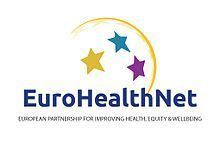Area served Europe Founded 1996 | Website www.eurohealthnet.eu | |
 | ||
Members 31 national member groups Type of business Not-for-profit partnership | ||
EuroHealthNet is a non-profit partnership of organisations, agencies and statutory bodies working to contribute to a healthier Europe by promoting health and health equity between and within European countries. EuroHealthNet achieves this through its partnership framework by supporting members’ work in EU and associated states through policy and project development, networking and communications. The network’s office has been located in Brussels since 1996 and staff members are experienced in engaging with the EU institutions, decision makers and a large number of stakeholders from public authorities, civil society, the corporate sector and academia. EuroHealthNet has connections with national and regional governments, as well as with the European institutions, and therefore a good understanding of how evidence and information on health equity can be introduced in current policy making agendas.
Contents
- Health inequalities and inequities in Europe
- EU Health Policy
- EuroHealthNets Mission
- Areas of work
- Projects
- Funding
- Members of Health Promotion Europe HPE
- Partners of the European Centre for Innovation Research and Implementation for Health and Well Being CIRI
- Partners of the European Platform on Health and Social Equity PHASE
- Observers to the EuroHealthNet Partnership
- References
The secretariat of around ten staff is based in Brussels and supports the partnership, which operates in three closely interlinked pillars:
Health inequalities and inequities in Europe
Health inequalities can be defined as “systematic differences in health between social groups” and populations. Health inequities, on the other hand, are unfair, “avoidable inequalities” of populations within and between countries. The WHO’s Committee on the Social Determinants of Health stated that the social gradient, - systematic differences between populations - was unfair; “killing people on a grand scale”.
Perhaps the clearest example of health inequalities can be seen in life expectancy. The difference between life expectancy at birth can vary by over a decade between European Union member states. For example, in 2012 the life expectancy at birth for Swedish males is 81 years, whereas in Lithuania a baby born could expect to only live until 68.4. In terms of healthy life years (years of life lived without disability) the gap is even greater, with Estonian males born in 2012 predicted to have 18.4 fewer healthy life years than their Maltese counterparts. These disparities in life expectancy don’t just exist at the macro scale, but can be seen right down to the neighbourhood level; with differences reaching into the decades. Such disparities are found world-wide, with a whole area of research looking at demographics and improving life expectancy.
EU Health Policy
Inequalities in health have been an important part of the work of the European Union (EU) since 1992 when specific competencies for public health were included in the Maastricht Treaty. However, as noted above large differences in health still exist between and within all countries in the EU, and some of these inequalities are widening. The EU institutions contribute to reducing health inequalities across the social gradient through a variety of strategies, policies, programmes and initiatives which affect the socio-economic determinants of health.
The Health programmes, the latest being 2014-2020, are one of the Commission’s main instruments for implementing policies aimed at reducing health inequalities. In 2009 the European Commission recognised the challenges and importance of reducing health inequities. In June 2010 the EU adopted its new strategy - Europe 2020: A strategy for smart, sustainable and inclusive growth. The document sets out the proposed economic, social and environmental development for the EU over the next 10 years. Although the strategy does not directly address health inequalities, it clearly acknowledges the need to fight inequalities as a prerequisite for growth and competitiveness. The EU has indeed committed to lift 20 million people out of poverty by 2020. This will be pursued through the European platform against poverty and social exclusion, one of the Commission’s seven 'flagship initiatives’ i.e. the mechanisms through which the EU 2020 strategy will be delivered. This process will undoubtedly impact health inequalities between and within EU countries.
EuroHealthNet’s Mission
EuroHealthNet seeks to address the factors that shape health and social inequalities, building the evidence base for public health and health-related policies and health promotion interventions in particular to level up the social gradient in health. The enjoyment of the highest attainable standard of health is one of the fundamental rights of every human being without distinction of race, religion, economic or social condition. EuroHealthNet therefore stimulates and supports the implementation of integrated approaches addressing the social determinants of health by operating at all levels and across the political spectrum in relevant health, social and employment fields.
Areas of work
Projects
Funding
EuroHealthNet is a non-profit partnership and receives funding from:
Members of Health Promotion Europe (HPE)
Members are national and regional institutes, academic and research centres, national and regional authorities and government departments. They operate networks in their communities comprising regional and local authorities, practitioners and professional bodies and non-profit organisations, and have wide communications and consultation links with wider stakeholders.
Partners of the European Centre for Innovation, Research and Implementation for Health and Well-Being (CIRI)
CIRI is EuroHealthNet’s research-oriented arm. It aims to promote evidence-based approaches to health and wellbeing across all groups in society. CIRI Partners include leading centres of research and public health who are committed to improving the uptake of evidence in policy making processes.
Partners of the European Platform on Health and Social Equity (PHASE)
PHASE is EuroHealthNet’s advocacy and policy-oriented body and brings together organisations willing to work on addressing the wider determinants of health.
Observers to the EuroHealthNet Partnership
The EuroHealthNet partnership allows ministerial and governmental bodies to participate in a limited, non-voting capacity.
